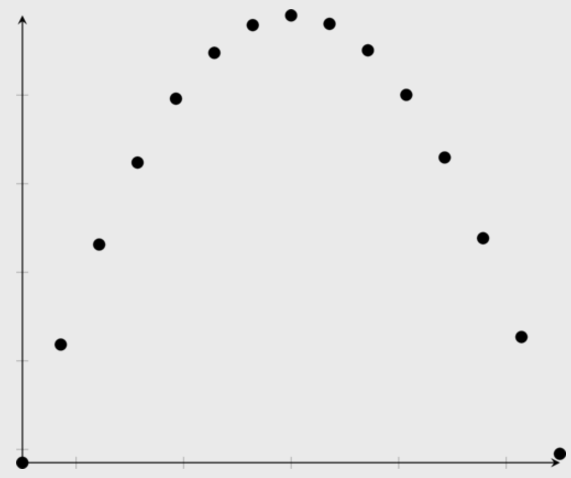
quadratic
|
Previous
9.1 Revision
|
Next
9.3 Correlation
|
In Grade 11, we used various means, such as histograms, frequency polygons and ogives, to visualise our data. These are very useful tools to depict univariate data, i.e. data with only one variable such as the height of learners in a class.
Last year we also learnt about a visual tool called scatter plots. Scatter plots are a common way to visualise bivariate data, i.e. data with two variables. This allows us to identify the direction and strength of a relationship between two variables.
We identify the nature of a relationship between two variables by examining if the points on the scatter plot conform to a linear, exponential, quadratic or some other function. The process of fitting functions to data is known as curve fitting.
The strength of a relationship can be described as strong if the data points conform closely to a function or weak if they are further away.
In the case of linear functions, the direction of a relationship is positive if high values of one variable occur with high values of the other or negative if high values of one variable occur with low values of the other.
The table below summarises the different relationships:
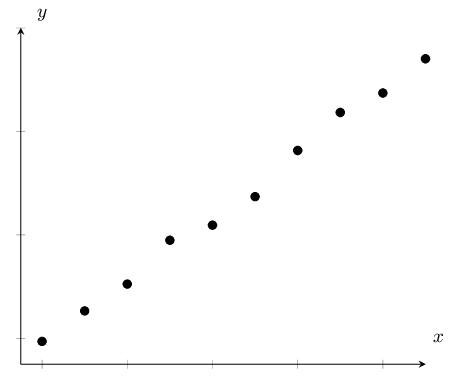 |
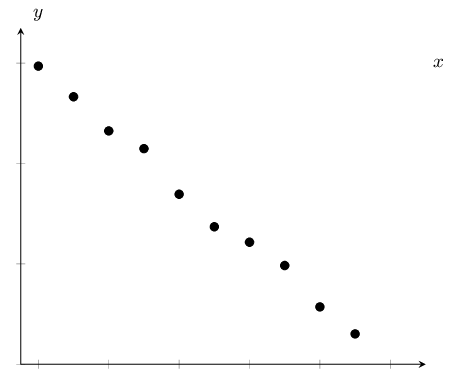 |
| Strong, positive linear relationship | Strong, negative linear relationship |
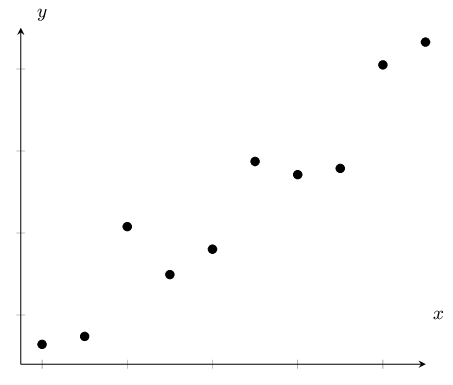 |
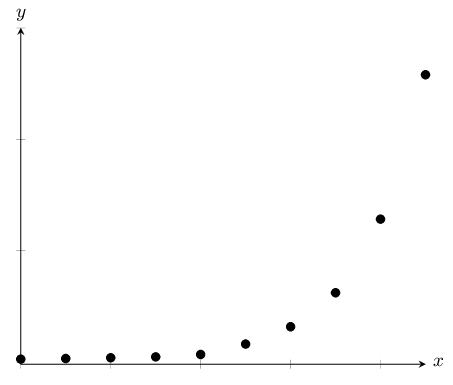 |
| Weak, positive linear relationship | Exponential relationship |
 |
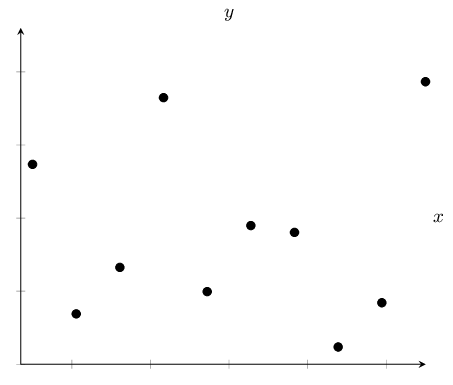 |
| Quadratic relationship | No relationship |
Examine the scatter plot below of data collected from a new shop:
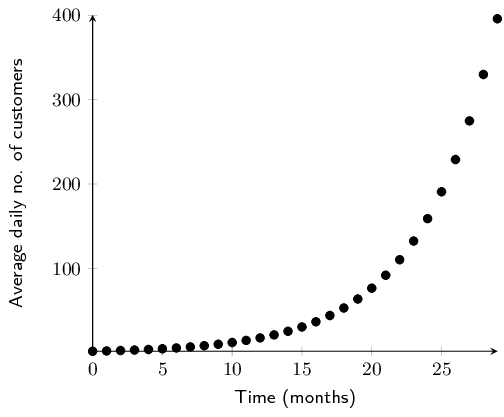
In the worked example above, by plotting the average daily customers and time data of a new shop on a scatter plot, we were able to identify the relationship between the two variables. Once we know the relationship between two variables, we are able to do another very useful thing - we are able to predict values where no data exist.
When we predict values that fall within the range of our data, this is known as interpolation. When we predict the values of a variable beyond the range of our data, this is known as extrapolation.
Extrapolation must be done with caution unless it is known that the observed relationship continues beyond the range of our data. For example, an exponential function may look linear if we only have the first few data points available but if we extrapolate far enough beyond the initial data points, our predictions will be inaccurate.
In order to interpolate or extrapolate values, we need to find the equation of the function which best fits the data. For linear data, we draw a straight line through the data which best approximates the available data points. This line is known as the line of best fit or trend line. Let us try our hand at this in the following example.
|
\(x\) |
\(\text{1,0}\) |
\(\text{2,4}\) |
\(\text{3,1}\) |
\(\text{4,9}\) |
\(\text{5,6}\) |
\(\text{6,2}\) |
|
\(y\) |
\(\text{2,5}\) |
\(\text{2,8}\) |
\(\text{3,0}\) |
\(\text{4,8}\) |
\(\text{5,1}\) |
\(\text{5,3}\) |
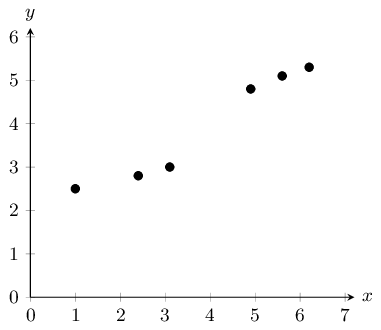
The next step is to draw a straight line which goes as close to as many points as possible. It is generally best to have as many points above the line as below the line.
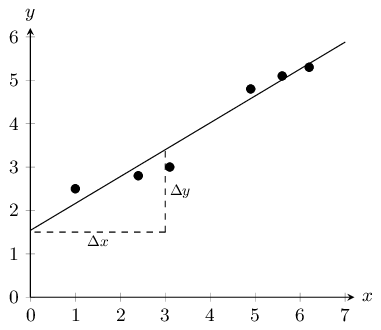
The equation of the line is
\(y=mx+c\)From the graph we have drawn, we estimate the y-intercept to be \(\text{1,5}\). We estimate that \(y=\text{3,5}\) when \(x=3\). So we have that points \(\left(3;\text{3,5}\right)\) and \(\left(0;\text{1,5}\right)\) lie on the line. The gradient of the line, m, is given by
\begin{align*} m & = \frac{\Delta y}{\Delta x} = \frac{{y}_{2}-{y}_{1}}{{x}_{2}-{x}_{1}} \\ & = \frac{\text{3,5}-\text{1,5}}{3-0} \\ & = \frac{2}{3} \end{align*}So we finally have that the equation of the line of best fit is
\(y=\frac{2}{3}x+\text{1,5}\)The equation of the line is \(y=\frac{2}{3}x+\text{1,5}\) so in order to find the unknown values, we insert the known values into our equation.
For \(x = 4\):
\begin{align*} y &=\frac{2}{3} \cdot 4 +\text{1,5}\\ &= \text{4,17} \end{align*}Since this \(x\)-value is within the data range, this is interpolation.
For \(y = 6\):
\begin{align*} 6 & =\frac{2}{3} \cdot x +\text{1,5} \\ \therefore x &= (6 - \text{1,5}) \times \frac{3}{2} \\ &= \text{6,75} \end{align*}Since this \(y\)-value is outside the data range, this is extrapolation.
Identify the function (linear, exponential or quadratic) which would best fit the data in each of the scatter plots below:

quadratic
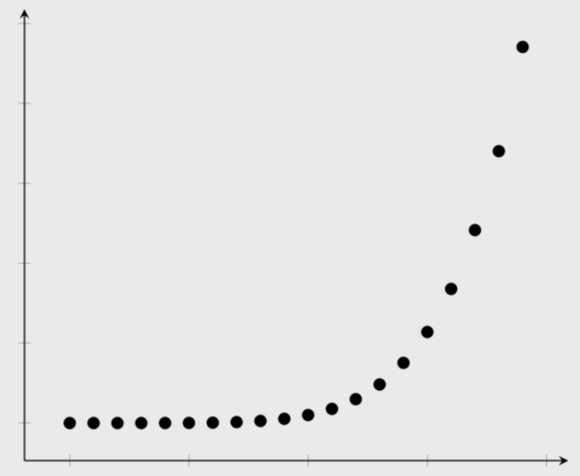
exponential

linear
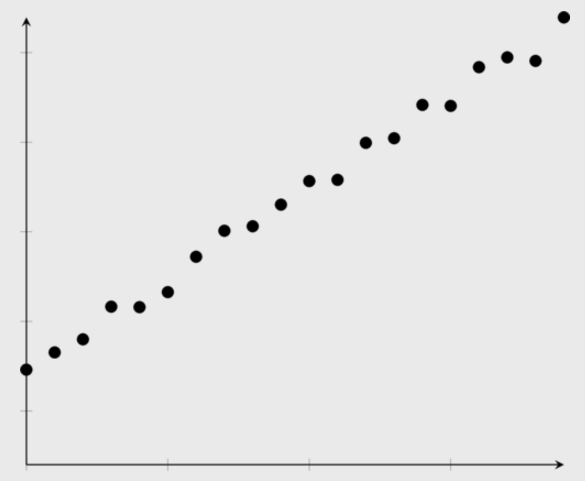
linear
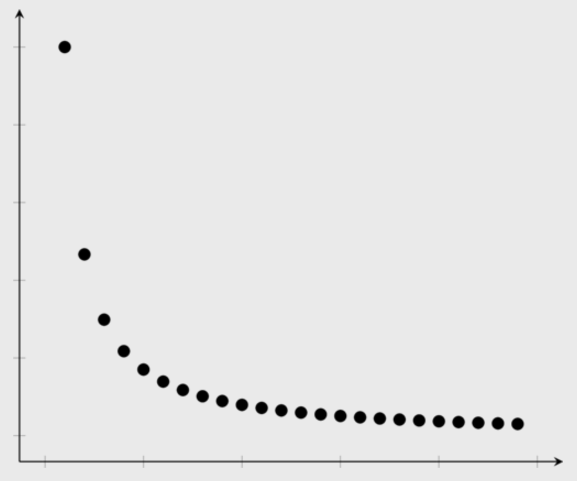
exponential
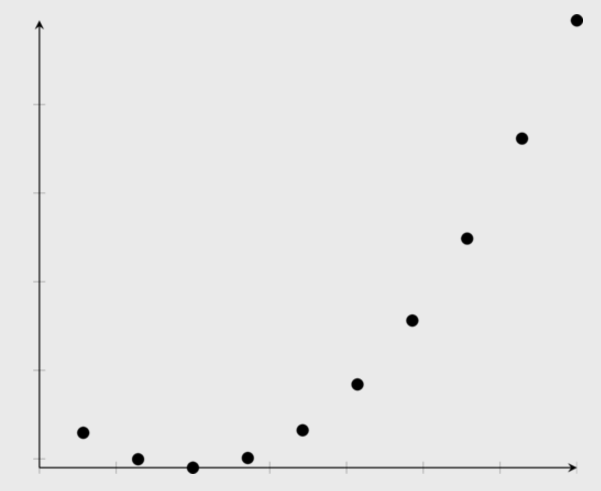
quadratic
Given the scatter plot below, answer the questions that follow.
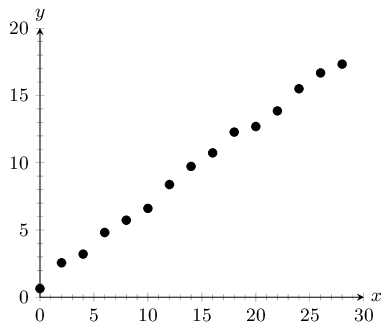
The data fit a strong, positive linear function.
NB: The answer to this question is learner dependent. The method is more important than the final answer. Pay special attention to the \(y\)-intercept of the line of best fit. Learners often draw their line through the origin, even when this is not appropriate. Below is an illustration of how the learner should go about finding the solution to this problem. The learner's answer does not have to look exactly like the model answer, but should at least be a good approximation.
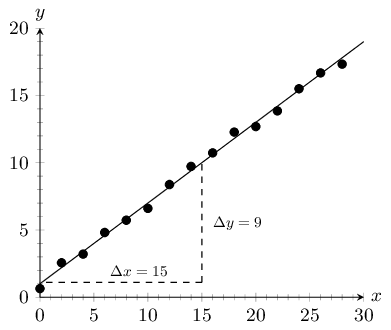
The \(y\)-intercept is approximately 1. The \(y\)-value at \(x = 15\) is approximately 10. Therefore, \(m = \frac{\Delta y}{\Delta x} = \frac{10-1}{15-0} = \text{0,6}\)
The equation for the line of best fit: \(y = \text{0,6}x + 1\)
Answer will depend on the learner's previous answer.
\begin{align*} y &=\text{0,6}(25)+1 \\ \therefore y &= \text{16} \end{align*}Answer will depend on the learner's previous answer.
\begin{align*} 25&=\text{0,6}x+1 \\ \therefore \text{0,6}x &= 24 \\ \therefore x = \frac{24}{\text{0,6}} &= \text{40} \end{align*}Tuberculosis (TB) is a disease of the lungs caused by bacteria which are spread through the air when an infected person coughs or sneezes. Drug-resistant TB arises when patients do not take their medication properly. Andile is a scientist studying a new treatment for drug-resistant TB. For his research, he needs to grow the TB bacterium. He takes two bacteria and puts them on a plate with nutrients for their growth. He monitors how the number of bacteria increases over time. Look at his data in the scatter plot below and answer the questions that follow.

Marelize is a researcher at the Department of Agriculture. She has noticed that farmers across the country have very different crop yields depending on the region. She thinks that this has to do with the different climate in each region. In order to test her idea, she collected data on crop yield and average summer temperatures from a number of farmers. Examine her data below and answer the questions that follow.
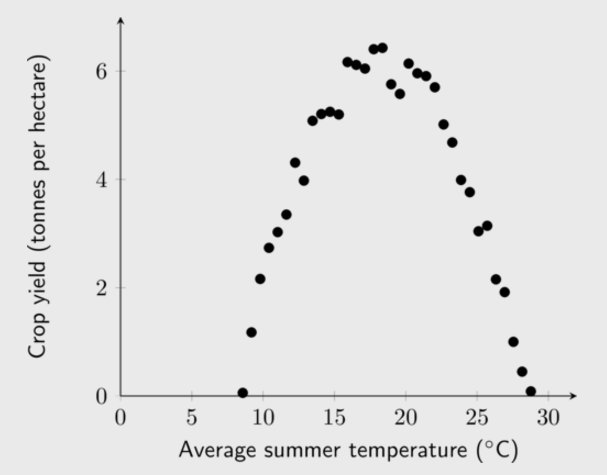
This question requires us to find the turning point of the function. There are a number of ways to do this; two are shown below:
The first method is using the formula \(x = \frac{-b}{2a}\):
Another method is using differentiation:
Therefore the optimal temperature to grow wheat is \(\text{18,33}\)\(\text{°C}\) and the respective crop yield is \(\text{6,17}\) \(\text{tonnes per hectare}\).
Dr Dandara is a scientist trying to find a cure for a disease which has an \(\text{80}\%\) mortality rate, i.e. \(\text{80}\%\) of people who get the disease will die. He knows of a plant which is used in traditional medicine to treat the disease. He extracts the active ingredient from the plant and tests different dosages (measured in milligrams) on different groups of patients. Examine his data below and complete the questions that follow.
|
Dosage (mg) |
\(\text{0}\) |
\(\text{25}\) |
\(\text{50}\) |
\(\text{75}\) |
\(\text{100}\) |
\(\text{125}\) |
\(\text{150}\) |
\(\text{175}\) |
\(\text{200}\) |
|
Mortality rate \((\%)\) |
\(\text{80}\) |
\(\text{73}\) |
\(\text{63}\) |
\(\text{49}\) |
\(\text{42}\) |
\(\text{32}\) |
\(\text{25}\) |
\(\text{11}\) |
\(\text{5}\) |

The data show a strong, negative linear relationship.
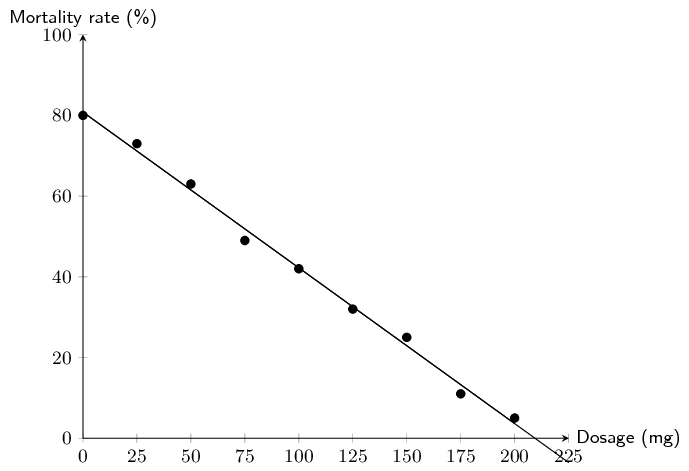
The \(y\)-intercept is approximately 80. The \(x\)-intercept is approximately 210. Therefore, \(m = \frac{\Delta y}{\Delta x} = \frac{80-0}{0-210} = -\text{0,38}\)
The equation for the line of best fit: \(y = -\text{0,38}x + 80\)
Dr Dandara used extrapolation to calculate the dosage where the mortality rate \(= \text{0}\%\). Extrapolation can result in incorrect estimates if the trend observed within the available data range does not continue outside of the range. In this case, it appears that at dosages greater than \(\text{200}\) \(\text{mg}\), the equation of the line of best fit no longer fits the data, therefore extrapolation produced a false estimate.
In the previous worked example and exercises, you drew the line of best fit by hand. This can give us a reasonable approximation of which function best fits the data when the data points are close together. However, you and your classmates may have found that you obtained slightly different answers from one another. In the next section, we will learn about a more precise way of fitting a linear function to data.
Linear regression analysis is a statistical technique for finding out exactly which linear function best fits a given set of data. We can find out the equation of the regression line by using an algebraic method called the least squares method, available on most scientific calculators. The linear regression equation is written \(\hat{y}=a+bx\) (we say y-hat) or \(y=A+Bx\). Of course these are both variations of the more familiar equation \(y=mx+c\).
The least squares method is very simple. Suppose we guess a line of best fit, then at every data point, we find the distance between the data point and the line. If the line fitted the data perfectly, this distance would be zero for all the data points. The worse the fit, the larger the differences. We then square each of these distances, and add them all together.
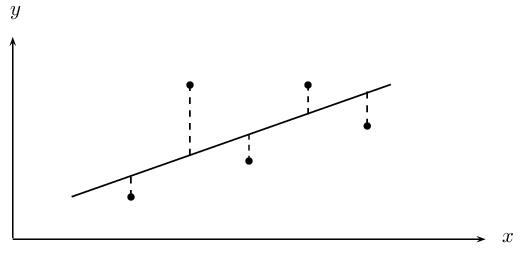
The best-fit line is then the line that minimises the sum of the squared distances.
Suppose we have a data set of \(n\) points \(\left\{\left({x}_{1};{y}_{1}\right),\left({x}_{2};{y}_{2}\right),...,\left({x}_{n};{y}_{n}\right)\right\}\). We also have a line \(f\left(x\right)=mx+c\) that we are trying to fit to the data. The distance between the first data point and the line, for example, is
\(\text{distance}={y}_{1}-f\left({x}_{1}\right)={y}_{1}-\left(m{x}_{1}+c\right)\)We now square each of these distances and add them together. Lets call this sum \(S\left(m,c\right)\). Then we have that
\begin{align*} S\left(m,c\right) & = {\left({y}_{1}-f\left({x}_{1}\right)\right)}^{2}+{\left({y}_{2}-f\left({x}_{2}\right)\right)}^{2}+\ldots +{\left({y}_{n}-f\left({x}_{n}\right)\right)}^{2} \\ & = \sum_{i=1}^{n}{\left({y}_{i}-f\left({x}_{i}\right)\right)}^{2} \end{align*}Thus our problem is to find the value of m and c such that \(S\left(m,c\right)\) is minimised. Let us call these minimising values \(b\) and \(a\) respectively. Then the line of best-fit is \(f\left(x\right)=a+bx\). We can find \(a\) and \(b\) using calculus, but it is tricky, and we will just give you the result, which is that
\begin{align*} b & = \frac{n{\sum }_{i=1}^{n}{x}_{i}{y}_{i}-{\sum }_{i=1}^{n}{x}_{i}{\sum }_{i=1}^{n}{y}_{i}}{n{\sum }_{i=1}^{n}{\left({x}_{i}\right)}^{2}-{\left({\sum }_{i=1}^{n}{x}_{i}\right)}^{2}} \\ a & = \frac{1}{n}\sum _{i=1}^{n}{y}_{i}-\frac{b}{n}\sum _{i=1}^{n}{x}_{i}=\bar{y}-b\bar{x} \end{align*}In the table below, we have the records of the maintenance costs in rands compared with the age of the appliance in months. We have data for five appliances. Determine the equation for the least squares regression line by hand.
|
Appliance |
1 |
2 |
3 |
4 |
5 |
|
Age (\(x\)) |
\(\text{5}\) |
\(\text{10}\) |
\(\text{15}\) |
\(\text{20}\) |
\(\text{30}\) |
|
Cost (\(y\)) |
\(\text{90}\) |
\(\text{140}\) |
\(\text{250}\) |
\(\text{300}\) |
\(\text{380}\) |
|
Appliance |
\(x\) |
\(y\) |
\(xy\) |
\({x}^{2}\) |
|
1 |
\(\text{5}\) |
\(\text{90}\) |
\(\text{450}\) |
\(\text{25}\) |
|
2 |
\(\text{10}\) |
\(\text{140}\) |
\(\text{1 400}\) |
\(\text{100}\) |
|
3 |
\(\text{15}\) |
\(\text{250}\) |
\(\text{3 750}\) |
\(\text{225}\) |
|
4 |
\(\text{20}\) |
\(\text{300}\) |
\(\text{6 000}\) |
\(\text{400}\) |
|
5 |
\(\text{30}\) |
\(\text{380}\) |
\(\text{11 400}\) |
\(\text{900}\) |
|
Total |
80 |
\(\text{1 160}\) |
\(\text{23 000}\) |
\(\text{1 650}\) |
Using a calculator, find the equation of the least squares regression line for the following data:
|
Days (\(x\)) |
1 |
2 |
3 |
4 |
5 |
|
Growth in m (\(y\)) |
\(\text{1,00}\) |
\(\text{2,50}\) |
\(\text{2,75}\) |
\(\text{3,00}\) |
\(\text{3,50}\) |
NB. If you have a CASIO calculator, do the next worked example first. Come back to this worked example once you are done and see if you get the same answer on your calculator.
Using your calculator, change the mode from normal to “Stat \(xy\) ”. Do this by pressing [2ndF] and then 2. This mode enables you to type in bivariate data.
Key in the data row by row:
|
Enter: |
Press: |
Enter: |
Press: |
See: |
|
1 |
\((x,y)\) |
1 |
DATA |
n = \(\text{1}\) |
|
2 |
\((x,y)\) |
\(\text{2,5}\) |
DATA |
n = \(\text{2}\) |
|
3 |
\((x,y)\) |
\(\text{2,75}\) |
DATA |
n = \(\text{3}\) |
|
4 |
\((x,y)\) |
\(\text{3,0}\) |
DATA |
n = \(\text{4}\) |
|
5 |
\((x,y)\) |
\(\text{3,5}\) |
DATA |
n = \(\text{5}\) |
Note: The [(\(x,y\))] button is the same as the [STO] button and the [DATA] button is the same as the [M+] button.
Ask for the values of the regression coefficients \(a\) and \(b\).
|
Press: |
Press: |
See: |
|
RCL |
\(a\) |
\(a=\text{0,9}\) |
|
RCL |
\(b\) |
\(b=\text{0,55}\) |
Using a calculator determine the least squares line of best fit for the following data set.
|
Learner |
1 |
2 |
3 |
4 |
5 |
|
Chemistry \((\%)\) |
\(\text{52}\) |
\(\text{55}\) |
\(\text{86}\) |
\(\text{71}\) |
\(\text{45}\) |
|
Accounting \((\%)\) |
\(\text{48}\) |
\(\text{64}\) |
\(\text{95}\) |
\(\text{79}\) |
\(\text{50}\) |
For a Chemistry mark of \(\text{65}\%\), what mark does the least squares line predict for Accounting?
NB. If you have a SHARP calculator, ensure that you have done the previous worked example first. Once you have completed the previous worked example, attempt this example using your calculator and see if you get the same answer.
Switch on the calculator. Press [MODE] and then select STAT by pressing [2]. The following screen will appear:
|
1 |
\(1-VAR\) |
2 |
\(A+BX\) |
|
3 |
\(_+C{X}^{2}\) |
4 |
\(lnX\) |
|
5 |
\(eX\) |
6 |
\(A.B\)\(X\) |
|
7 |
\(A.XB\) |
8 |
\(1/X\) |
Now press [2] for linear regression. Your screen should look something like this:
|
\(x\) |
\(y\) |
|
|
1 |
||
|
2 |
||
|
3 |
Press [52] and then [\(=\)] to enter the first mark under \(x\). Then enter the other values, in the same way, for the \(x\)-variable (the Chemistry marks) in the order in which they are given in the data set. Then move the cursor across and up and enter 48 under y opposite 52 in the \(x\)-column. Continue to enter the other \(y\)-values (the Accounting marks) in order so that they pair off correctly with the corresponding \(x\)-values.
|
\(x\) |
\(y\) |
|
|
1 |
52 |
|
|
2 |
55 |
|
|
3 |
Then press [AC]. The screen clears but the data remains stored.
Now press [SHIFT][1] to get the stats computations screen shown below.
|
1: |
Type |
2: |
Data |
|
3: |
Edit |
4: |
Sum |
|
5: |
Var |
6: |
MinMax |
|
7: |
Reg |
Choose Regression by pressing [7].
|
1: |
A |
2: |
B |
|
3: |
r |
4: |
\(\hat{x}\) |
|
5: |
\(\hat{y}\) |
Press [1] and [=] to get the value of the \(y\)-intercept, \(a=-\text{5,065} \ldots = -\text{5,07}\) (to two decimal places)
Finally, to get the slope, use the following key sequence: [SHIFT][1][7][2][\(=\)]. The calculator gives \(b=\text{1,169} \ldots = \text{1,17}\) (to two decimal places)
The equation of the line of regression is thus:
\(\hat{y}=-\text{5,07}+\text{1,17}x\)
Press [AC][65][SHIFT][1][7][5][\(=\)]
This gives a (predicted) Accounting mark of \(=\text{70,94}=\text{71}\%\)
Determine the equation of the least-squares regression line using a table for the data sets below. Round \(a\) and \(b\) to two decimal places.
| \(x\) | \(\text{10}\) | \(\text{4}\) | \(\text{9}\) | \(\text{11}\) | \(\text{11}\) | \(\text{6}\) | \(\text{8}\) | \(\text{18}\) | \(\text{9}\) | \(\text{13}\) |
| \(y\) | \(\text{1}\) | \(\text{0}\) | \(\text{6}\) | \(\text{3}\) | \(\text{9}\) | \(\text{5}\) | \(\text{9}\) | \(\text{8}\) | \(\text{7}\) | \(\text{15}\) |
|
\(x\) |
\(y\) |
\(xy\) |
\({x}^{2}\) |
|
\(\text{10}\) |
\(\text{1}\) |
\(\text{10}\) |
\(\text{100}\) |
|
\(\text{4}\) |
\(\text{0}\) |
\(\text{0}\) |
\(\text{16}\) |
|
\(\text{9}\) |
\(\text{6}\) |
\(\text{54}\) |
\(\text{81}\) |
|
\(\text{11}\) |
\(\text{3}\) |
\(\text{33}\) |
\(\text{121}\) |
|
\(\text{11}\) |
\(\text{9}\) |
\(\text{99}\) |
\(\text{121}\) |
|
\(\text{6}\) |
\(\text{5}\) |
\(\text{30}\) |
\(\text{36}\) |
|
\(\text{8}\) |
\(\text{9}\) |
\(\text{72}\) |
\(\text{64}\) |
|
\(\text{18}\) |
\(\text{8}\) |
\(\text{144}\) |
\(\text{324}\) |
|
\(\text{9}\) |
\(\text{7}\) |
\(\text{63}\) |
\(\text{81}\) |
|
\(\text{13}\) |
\(\text{15}\) |
\(\text{195}\) |
\(\text{169}\) |
| \(\sum=\text{99}\) | \(\sum=\text{63}\) | \(\sum=\text{700}\) | \(\sum=\text{1 113}\) |
| \(x\) | \(\text{8}\) | \(\text{12}\) | \(\text{12}\) | \(\text{7}\) | \(\text{6}\) | \(\text{14}\) | \(\text{8}\) | \(\text{14}\) | \(\text{14}\) | \(\text{17}\) |
| \(y\) | \(-\text{5}\) | \(\text{4}\) | \(\text{3}\) | \(-\text{3}\) | \(-\text{5}\) | \(-\text{6}\) | \(-\text{2}\) | \(\text{0}\) | \(-\text{4}\) | \(\text{3}\) |
|
\(x\) |
\(y\) |
\(xy\) |
\({x}^{2}\) |
|
\(\text{8}\) |
\(-\text{5}\) |
\(-\text{40}\) |
\(\text{64}\) |
|
\(\text{12}\) |
\(\text{4}\) |
\(\text{48}\) |
\(\text{144}\) |
|
\(\text{12}\) |
\(\text{3}\) |
\(\text{36}\) |
\(\text{144}\) |
|
\(\text{7}\) |
\(-\text{3}\) |
\(-\text{21}\) |
\(\text{49}\) |
|
\(\text{6}\) |
\(-\text{5}\) |
\(-\text{30}\) |
\(\text{36}\) |
|
\(\text{14}\) |
\(-\text{6}\) |
\(-\text{84}\) |
\(\text{196}\) |
|
\(\text{8}\) |
\(-\text{2}\) |
\(-\text{16}\) |
\(\text{64}\) |
|
\(\text{14}\) |
\(\text{0}\) |
\(\text{0}\) |
\(\text{196}\) |
|
\(\text{14}\) |
\(-\text{4}\) |
\(-\text{56}\) |
\(\text{196}\) |
|
\(\text{17}\) |
\(\text{3}\) |
\(\text{51}\) |
\(\text{289}\) |
| \(\sum=\text{112}\) | \(\sum=-\text{15}\) | \(\sum=-\text{112}\) | \(\sum=\text{1 378}\) |
| \(x\) | \(-\text{9}\) | \(\text{3}\) | \(\text{4}\) | \(\text{7}\) | \(\text{13}\) | \(\text{6}\) | \(\text{0}\) | \(\text{8}\) | \(\text{1}\) | \(\text{14}\) |
| \(y\) | \(\text{0}\) | \(-\text{12}\) | \(-\text{10}\) | \(-\text{14}\) | \(-\text{31}\) | \(-\text{32}\) | \(-\text{41}\) | \(-\text{52}\) | \(-\text{51}\) | \(-\text{63}\) |
|
\(x\) |
\(y\) |
\(xy\) |
\({x}^{2}\) |
|
\(-\text{9}\) |
\(\text{0}\) |
\(\text{0}\) |
\(\text{81}\) |
|
\(\text{3}\) |
\(-\text{12}\) |
\(-\text{36}\) |
\(\text{9}\) |
|
\(\text{4}\) |
\(-\text{10}\) |
\(-\text{40}\) |
\(\text{16}\) |
|
\(\text{7}\) |
\(-\text{14}\) |
\(-\text{98}\) |
\(\text{49}\) |
|
\(\text{13}\) |
\(-\text{31}\) |
\(-\text{403}\) |
\(\text{169}\) |
|
\(\text{6}\) |
\(-\text{32}\) |
\(-\text{192}\) |
\(\text{36}\) |
|
\(\text{0}\) |
\(-\text{41}\) |
\(\text{0}\) |
\(\text{0}\) |
|
\(\text{8}\) |
\(-\text{52}\) |
\(-\text{416}\) |
\(\text{64}\) |
|
\(\text{1}\) |
\(-\text{51}\) |
\(-\text{51}\) |
\(\text{1}\) |
|
\(\text{14}\) |
\(-\text{63}\) |
\(-\text{882}\) |
\(\text{196}\) |
| \(\sum=\text{47}\) | \(\sum=-\text{306}\) | \(\sum=-\text{2 118}\) | \(\sum=\text{621}\) |
Use your calculator to determine the equation of the least squares regression line for the following sets of data:
| \(x\) | \(\text{0,16}\) | \(\text{0,32}\) | 3 | \(\text{2,6}\) | \(\text{6,12}\) | \(\text{7,68}\) | \(\text{6,16}\) | \(\text{8,56}\) | \(\text{11,24}\) | \(\text{11,96}\) |
| \(y\) | \(\text{5,48}\) | \(\text{10,56}\) | \(\text{13,4}\) | \(\text{15,96}\) | \(\text{15,44}\) | \(\text{16,6}\) | \(\text{17,2}\) | \(\text{22,28}\) | \(\text{22,04}\) | \(\text{24,32}\) |
| \(x\) | \(-\text{3,5}\) | \(\text{5,5}\) | \(\text{4}\) | \(\text{1}\) | \(\text{5,5}\) | \(\text{5}\) | \(\text{3,5}\) | \(\text{5,5}\) | \(\text{7,5}\) | \(\text{8,5}\) |
| \(y\) | \(-\text{10}\) | \(-\text{20,5}\) | \(-\text{30,5}\) | \(-\text{46}\) | \(-\text{46,5}\) | \(-\text{64,5}\) | \(-\text{67}\) | \(-\text{76,5}\) | \(-\text{83,5}\) | \(-\text{94}\) |
| \(x\) | \(\text{2,5}\) | \(\text{4,5}\) | \(-\text{2}\) | \(\text{9}\) | \(\text{8,5}\) | \(\text{10}\) | \(\text{7,5}\) | \(\text{3}\) | \(\text{8}\) | \(\text{15}\) |
| \(y\) | \(-\text{2}\) | \(\text{6}\) | \(\text{11}\) | \(\text{11,5}\) | \(\text{17}\) | \(\text{21}\) | \(\text{21}\) | \(\text{30,5}\) | \(\text{32,5}\) | \(\text{33,5}\) |
| \(x\) | \(\text{7,24}\) | \(\text{8,24}\) | \(\text{5,34}\) | \(\text{1,66}\) | \(\text{0,32}\) | \(\text{11,46}\) | \(\text{9,34}\) | \(\text{14,24}\) | \(\text{12,9}\) | \(\text{12,34}\) |
| \(y\) | \(-\text{3,2}\) | \(-\text{18,78}\) | \(-\text{21,1}\) | \(-\text{32}\) | \(-\text{31,2}\) | \(-\text{53,02}\) | \(-\text{53}\) | \(-\text{65,46}\) | \(-\text{74,8}\) | \(-\text{80,24}\) |
| \(x\) | \(-\text{0,28}\) | \(\text{2,32}\) | \(\text{0,12}\) | \(\text{4,64}\) | \(\text{3,08}\) | \(\text{7,92}\) | \(\text{5,08}\) | \(\text{8,96}\) | \(\text{10,28}\) | \(\text{7,12}\) |
| \(y\) | \(-\text{6,88}\) | \(-\text{0,32}\) | \(\text{3,68}\) | \(\text{4,8}\) | \(\text{11,68}\) | \(\text{19,2}\) | \(\text{20,96}\) | \(\text{24,96}\) | \(\text{29,28}\) | \(\text{33,28}\) |
| \(x\) | \(\text{1}\) | \(\text{1,1}\) | \(\text{4,8}\) | \(\text{3,55}\) | \(\text{2,75}\) | \(\text{1,95}\) | \(\text{6,1}\) | \(\text{8,9}\) | \(\text{10,35}\) | \(\text{9,55}\) |
| \(y\) | \(-\text{8,45}\) | \(-\text{5,95}\) | \(-\text{4,35}\) | \(\text{0,85}\) | \(-\text{2,95}\) | \(-\text{1,8}\) | \(\text{0,25}\) | \(\text{0,05}\) | \(\text{4,8}\) | \(-\text{3,05}\) |
| \(x\) | \(\text{1,9}\) | \(\text{1,1}\) | \(-\text{1,5}\) | \(\text{1,3}\) | \(\text{0,95}\) | \(\text{8,25}\) | \(\text{10,6}\) | \(\text{6,2}\) | \(\text{8,1}\) | \(\text{8,65}\) |
| \(y\) | \(\text{7}\) | \(\text{8,45}\) | \(\text{0,9}\) | \(\text{0,1}\) | \(\text{2,45}\) | \(\text{4,35}\) | \(\text{2,2}\) | \(\text{1,4}\) | \(\text{0,15}\) | \(\text{2,05}\) |
| \(x\) | \(-\text{81,8}\) | \(\text{73,1}\) | \(\text{84}\) | \(\text{92,2}\) | \(-\text{69,7}\) | \(-\text{56,1}\) | \(\text{8,8}\) | \(\text{80,9}\) | \(\text{68,4}\) | \(-\text{40,4}\) |
| \(y\) | \(\text{10,6}\) | \(\text{16,1}\) | \(\text{3,6}\) | \(\text{4,6}\) | \(\text{11,9}\) | \(\text{18,3}\) | \(\text{16,6}\) | \(\text{17,6}\) | \(\text{17,7}\) | \(\text{24,1}\) |
| \(x\) | \(\text{2,8}\) | \(\text{7,4}\) | \(-\text{2,4}\) | \(\text{4}\) | \(\text{11,3}\) | \(\text{6,9}\) | \(\text{2,5}\) | \(\text{1,7}\) | \(\text{5,4}\) | \(\text{8,2}\) |
| \(y\) | \(\text{12,4}\) | \(\text{13,4}\) | \(\text{15,3}\) | \(\text{15,4}\) | \(\text{16,4}\) | \(\text{19,2}\) | \(\text{21,1}\) | \(\text{19,4}\) | \(\text{21,3}\) | \(\text{25}\) |
| \(x\) | \(\text{5}\) | \(\text{1,2}\) | \(\text{8}\) | \(\text{6}\) | \(\text{7,4}\) | \(\text{7,4}\) | \(\text{6,7}\) | \(\text{8,7}\) | \(\text{12,2}\) | \(\text{14,3}\) |
| \(y\) | \(-\text{4,2}\) | \(-\text{13,7}\) | \(-\text{23,7}\) | \(-\text{33,5}\) | \(-\text{43,8}\) | \(-\text{54,2}\) | \(-\text{63,9}\) | \(-\text{73,9}\) | \(-\text{84,5}\) | \(-\text{93,5}\) |
Determine the equation of the least squares regression line given each set of data values below. Round \(a\) and \(b\) to two decimal places in your final answer.
\(n = 10; \enspace \sum x = \text{74}; \enspace \sum y = \text{424}; \enspace \sum xy = \text{4 114,51};\enspace \sum (x^{2}) = \text{718,86}\)
\(n = 13; \enspace \bar{x} = \text{8,45}; \enspace \bar{y} = \text{17,83}; \enspace \sum xy = \text{1 879,25}; \enspace \sum (x^{2}) = \text{855,45}\)
\(n = 10; \enspace \bar{x} = \text{5,77}; \enspace \bar{y} = \text{17,03}; \enspace \overline{xy} = \text{133,817}; \enspace \sigma_x = \pm \text{3,91} \\\) (Hint: multiply the numerator and denominator of the formula for \(b\) by \(\frac{1}{n^{2}}\))
The table below shows the average maintenance cost in rands of a certain model of car compared to the age of the car in years.
| Age (\(x\)) | \(\text{1}\) | \(\text{3}\) | \(\text{5}\) | \(\text{6}\) | \(\text{8}\) | \(\text{9}\) | \(\text{10}\) |
| Cost (\(y\)) | \(\text{1 000}\) | \(\text{1 500}\) | \(\text{1 600}\) | \(\text{1 800}\) | \(\text{2 000}\) | \(\text{2 400}\) | \(\text{2 600}\) |
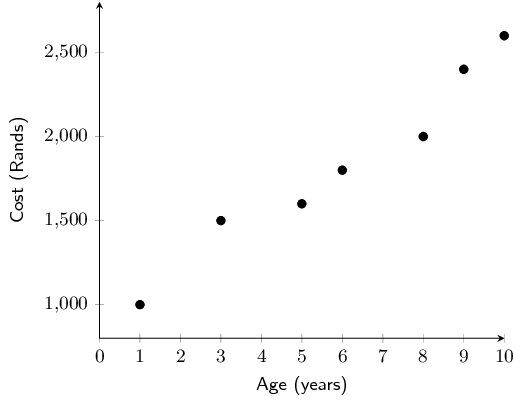
| Age (\(x\)) | Cost (\(y\)) | \(xy\) | \(x^{2}\) |
| 1 | \(\text{1 000}\) | ||
| 3 | \(\text{1 500}\) | ||
| 5 | \(\text{1 600}\) | ||
| 6 | \(\text{1 800}\) | ||
| 8 | \(\text{2 000}\) | ||
| 9 | \(\text{2 400}\) | ||
| 10 | \(\text{2 600}\) | ||
| \(\sum = \ldots\) | \(\sum = \ldots\) | \(\sum = \ldots\) | \(\sum = \ldots\) |
| Age (\(x\)) | Cost (\(y\)) | \(xy\) | \(x^{2}\) |
| 1 | \(\text{1 000}\) | \(\text{1 000}\) | 1 |
| 3 | \(\text{1 500}\) | \(\text{4 500}\) | 9 |
| 5 | \(\text{1 600}\) | \(\text{8 000}\) | 25 |
| 6 | \(\text{1 800}\) | \(\text{10 800}\) | 36 |
| 8 | \(\text{2 000}\) | \(\text{16 000}\) | 64 |
| 9 | \(\text{2 400}\) | \(\text{21 600}\) | 81 |
| 10 | \(\text{2 600}\) | \(\text{26 000}\) | 100 |
| \(\sum=42\) | \(\sum=\text{12 900}\) | \(\sum=\text{87 900}\) | \(\sum=316\) |
Miss Colly has always maintained that there is a relationship between a learner's ability to understand the language of instruction and their marks in Mathematics. Since she teaches Mathematics through the medium of English, she decides to compare the Mathematics and English marks of her learners in order to investigate the relationship between the two marks. A sample of her data is shown in the table below:
| English \% (\(x\)) | 28 | 33 | 30 | 45 | 45 | 55 | 55 | 65 | 70 | 76 | 65 | 85 | 90 |
| Mathematics \% (\(y\)) | 35 | 36 | 34 | 45 | 50 | 40 | 60 | 50 | 65 | 85 | 70 | 80 | 90 |
| English \% (\(x\)) | Mathematics \% (\(y\)) | \(xy\) | \(x^{2}\) |
| \(\text{28}\) | \(\text{35}\) | ||
| \(\text{33}\) | \(\text{36}\) | ||
| \(\text{30}\) | \(\text{34}\) | ||
| \(\text{45}\) | \(\text{45}\) | ||
| \(\text{45}\) | \(\text{50}\) | ||
| \(\text{55}\) | \(\text{40}\) | ||
| \(\text{65}\) | \(\text{50}\) | ||
| \(\text{70}\) | \(\text{65}\) | ||
| \(\text{76}\) | \(\text{85}\) | ||
| \(\text{65}\) | \(\text{70}\) | ||
| \(\text{85}\) | \(\text{80}\) | ||
| \(\text{90}\) | \(\text{90}\) | ||
| \(\sum = \ldots\) | \(\sum = \ldots\) | \(\sum = \ldots\) | \(\sum = \ldots\) |
| English \% (\(x\)) | Mathematics \% (\(y\)) | \(xy\) | \(x^{2}\) |
| \(\text{28}\) | \(\text{35}\) | \(\text{980}\) | \(\text{784}\) |
| \(\text{33}\) | \(\text{36}\) | \(\text{1 188}\) | \(\text{1 089}\) |
| \(\text{30}\) | \(\text{34}\) | \(\text{1 020}\) | \(\text{900}\) |
| 45 | 45 | \(\text{2 025}\) | \(\text{2 025}\) |
| 45 | 50 | \(\text{2 250}\) | \(\text{2 025}\) |
| 55 | 40 | \(\text{2 200}\) | \(\text{3 025}\) |
| 65 | 50 | \(\text{3 250}\) | \(\text{4 225}\) |
| 70 | 65 | \(\text{4 550}\) | \(\text{4 900}\) |
| 76 | 85 | \(\text{6 460}\) | \(\text{5 776}\) |
| 65 | 70 | \(\text{4 550}\) | \(\text{4 225}\) |
| 85 | 80 | \(\text{6 800}\) | \(\text{7 225}\) |
| 90 | 90 | \(\text{8 100}\) | \(\text{8 100}\) |
| \(\sum=742\) | \(\sum=740\) | \(\sum=\text{46 673}\) | \(\sum=\text{47 324}\) |
Foot lengths and heights of ten students are given in the table below.
|
Height (cm) |
\(\text{170}\) |
\(\text{163}\) |
\(\text{131}\) |
\(\text{181}\) |
\(\text{146}\) |
\(\text{134}\) |
\(\text{166}\) |
\(\text{172}\) |
\(\text{185}\) |
\(\text{153}\) |
|
Foot length (cm) |
\(\text{27}\) |
\(\text{23}\) |
\(\text{20}\) |
\(\text{28}\) |
\(\text{22}\) |
\(\text{20}\) |
\(\text{24}\) |
\(\text{26}\) |
\(\text{29}\) |
\(\text{22}\) |
Using foot length as your \(x\)-variable, draw a scatter plot of the data.
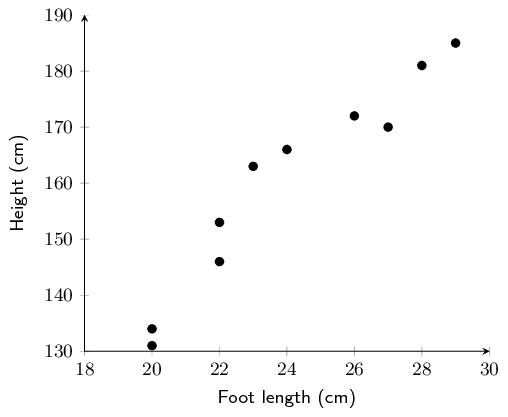
Identify and describe any trends shown in the scatter plot.
Strong (or fairly strong), positive, linear trend
Find the equation of the least squares line using the formulae and draw the line on your graph. Round \(a\) and \(b\) to two decimal places in your final answer.
| Foot length (\(x\)) | Height (\(y\)) | \(xy\) | \(x^{2}\) |
| 27 | \(\text{170}\) | \(\text{4 590}\) | 729 |
| 23 | \(\text{163}\) | \(\text{3 749}\) | 529 |
| 20 | \(\text{131}\) | \(\text{2 620}\) | 400 |
| 28 | \(\text{181}\) | \(\text{5 068}\) | 784 |
| 22 | \(\text{146}\) | \(\text{3 212}\) | 484 |
| 20 | \(\text{134}\) | \(\text{2 680}\) | 400 |
| 24 | \(\text{166}\) | \(\text{3 984}\) | 576 |
| 26 | \(\text{172}\) | \(\text{4 472}\) | 676 |
| 29 | \(\text{185}\) | \(\text{5 365}\) | 841 |
| 22 | \(\text{153}\) | \(\text{3 366}\) | 484 |
| \(\sum=241\) | \(\sum=\text{1 601}\) | \(\sum=\text{39 106}\) | \(\sum=\text{5 903}\) |
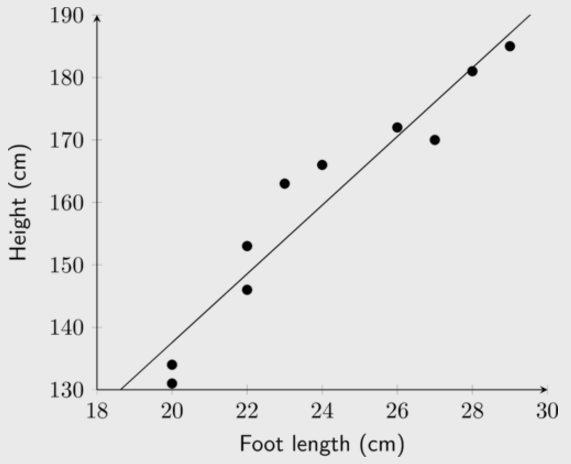
Confirm your calculations above by finding the least squares regression line using a calculator.
Use your equation to predict the height of a student with a foot length of \(\text{21,6}\) \(\text{cm}\).
Use your equation to predict the foot length of a student \(\text{190}\) \(\text{cm}\) tall, correct to two decimal places.
Now that we have a precise technique for finding the line of best fit, we still do not know how well our line of best fit really fits our data. We can fit a least squares regression line to any bivariate data, even if the two variables do not show a linear relationship. If the fit is not “good”, our assumption of the \(a\) and \(b\) values in \(\hat{y}=a+bx\) might be incorrect. Next, we will learn of a quantitative measure to determine how well our line really fits our data.
|
Previous
9.1 Revision
|
Table of Contents |
Next
9.3 Correlation
|